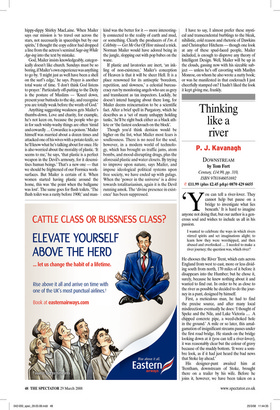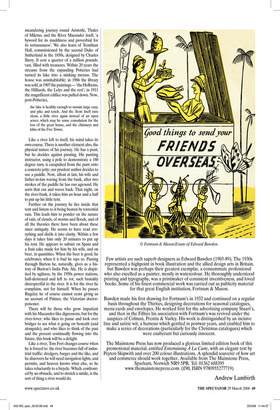Thinking like a river
P. J. Kavanagh
DOWNSTREAM by Tom Fort Century, £14.99, pp. 310, ISBN 9781846051692 ✆ £11.99 (plus £2.45 p&p) 0870 429 6655 ‘You can tell a river-lover. They cannot help but pause on a bridge to investigate what lies beneath.’ It is hard to imagine anyone not doing that, but our author is a gen erous soul and wishes to include us all in his passion.
I wanted to celebrate the ways in which rivers stirred spirits and set imaginations alight; to learn how they were worshipped, and then abused and overlooked ... I needed to make a river journey; the question was, which river?
He chooses the River Trent, which cuts across England from west to east, more or less divid ing south from north, 170 miles of it before it disappears into the Humber; but he chose it, surely, because he knew nothing about it and wanted to find out. In order to be as close to the river as possible he decided to do the jour ney in a punt, designed by himself.
First, a meticulous man, he had to find the precise source, and after many local misdirections eventually he does: ‘I thought of Speke and the Nile, and Lake Victoria ... A chipped concrete pipe, a weed-choked hole in the ground.’ A mile or so later, this amal gamation of insignificant streams passes under the first road bridge. He stands on the bridge looking down at it (you can tell a river-lover), it was reasonably clear but the colour of gravy because of the muddy bottom. ‘It wore a som bre look, as if it had just heard the bad news that Stoke lay ahead.’ His designer-punt awaited him at Trentham, downstream of Stoke, brought there on a trailer by his wife. Before he joins it, however, we have been taken on a meandering journey round Aristotle, Thales of Miletus, and the River Maeander itself, ‘a byword for its muddiness and proverbial for its tortuousness’. We also learn of Trentham Hall, commissioned by the second Duke of Sutherland in the 1850s, designed by Charles Barry. It cost a quarter of a million pounds: vast, filled with treasures. Within 20 years the streams from the expanding Potteries had turned its lake into a stinking morass. The house was uninhabitable; in 1906 the library was sold, in 1907 the paintings — ‘the Holbeins, the Hilliards, the Lelys and the rest’; in 1911 the magnificent edifice was pulled down. Now, post-Potteries,
the lake is healthy enough to sustain large carp, and pike and tench. And the Trent itself runs clean, a little river again instead of an open sewer, which may be some consolation for the loss of the great house, and the chimneys and kilns of the Five Towns.
Like a river left to itself, his mind takes its own course. There is another element also, the physical nature of his journey. He has a punt, but he decides against punting. His punting instructor, using a pole to demonstrate a 180 degree turn, is catapulted from the punt onto a concrete jetty; our prudent author decides to use a paddle. Now, afloat at last, his wife and father-in-law waving from the bank, after two strokes of the paddle he has run aground. He sorts that out and waves back. That night, on the river-bank, it takes him an hour and a half to put up his little tent.
Further on the journey he lies inside that tent and listens to it being beaten by torrential rain. This leads him to ponder on the nature of rain, of clouds, of storms and floods, and of all the theories there have been about these since antiquity. He seems to have read everything and distils it into clarity. Within a few days it takes him only 20 minutes to put up his tent. He appears to subsist on Spam and a fruit cake made for him by his wife, and on beer, in quantities. When the beer is good, he celebrates; when it is bad he says so. Passing through Burton he, naturally, gives us a history of Burton’s India Pale Ale. He is dispirited by ugliness, by the 1950s power stations, half-destroyed and left to rot, such brutality disrespectful to the river. It is for the river he complains, not for himself. When he passes Rugeley he of course cannot resist giving us an account of Palmer, the Victorian doctorpoisoner.
There will be those who grow impatient with his Maeander-like digressions, but for the river-lover, who likes to pause and look over bridges to see what is going on beneath (and alongside), and who likes to think of the past and the present continually flowing into the future, this book will be a delight.
Like a river, Tom Fort changes course when he is forced to: the river becomes full of industrial traffic: dredgers, barges and the like, and he discovers he will need navigation lights, and permits, and heaven knows what else, so he takes reluctantly to a bicycle. Which, confronted by an obstacle, and to stretch a simile, is the sort of thing a river would do.

















































































 Previous page
Previous page